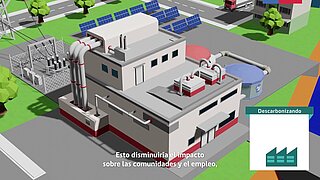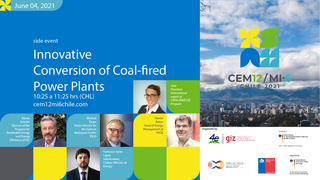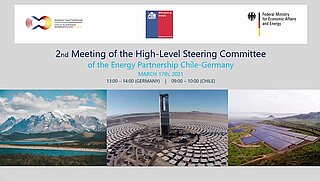Coal Phase-out in Chile

Since the 1990’s, Chile has experienced consistent economic growth, leading to a steady increase in the country's energy requirements. In order to guarantee sufficient energy supply after the Argentinian natural gas shortage cisis in 2005, new coal-powered thermal plants were built on imported coal (almost 100% of the coal needs to be imported). However, the effects on climate are clearly visible today: the entire Chilean energy sector is responsible for 78 percent of the country's emissions, 32 percent of which is accounted for by electricity generation. In the past,40 percent of Chile's electricity generation was based on coal, but by January 2025, this figure has dropped to less than 20%. There are 17 (before 28) coal-fired power plant units with a total installed capacity of 3,8 GW (5,5 GW, 2019), operated by two multinational and one national company.
Chile has the potential to offer more than 1,800 GW in renewable energy, making it a promising prospect for the future. The country's ambitious decarbonisation goals, set to be achieved through a complete coal phase-out, have been further reinforced by the establishment of a specialised coal commission in 2018 to develop recommended actions for the government and evaluate various exit strategies. On June 11th, 2018 the inaugural meeting of the Chilean Coal Commission took place with 25 representatives from companies and institutions. Until January 2019, a total of nine meetings of the Coal Commission had been held. On June 4th, 2019, the then Chilean President Sebastian Piñera announced the start of the phase-out with the decommissioning of eight coal-fired power plants by 2024. Official protocols have been signed with each of the four coal-fired power plant operators, in which the companies agree to decarbonize and declare their willingness to invest in renewable energies at the same time.
These concrete commitments have been further extended, with two additional coal power plants added to the first phase-out period at the COP25. Since then, the government and the operators have made further announcements to accelerate the process. Between May 2020 and July 2021, another eight coal-fired power plants were included in the shutdown phase until 2025. Thanks to these efforts, Chile is on its way to phasing out coal from its energy matrix, expecting to have decommissioned 18 out of 28 power plants, equivalent to 65% of the coal capacity, by 2025. The subsequent shutdowns after 2025 are to be defined depending on the development of Chile's electricity demand and the speed at which renewable energies are added and integrated into the Chilean power grid. in Chile, the deadline for closure of all coal-fired power plants in the country is 2040 at the latest.
Topics covered by the Round Table on Coal Phase-out and/or Reconversion of Coal Units
The necessary restructuring of power generation has wide-ranging implications in several areas. On the one hand, the integration of a more diverse range of renewable energies like wind and solar into the power grid must be ensured. The stability of the Chilean electricity system (a linear grid with island character) and the low age of some existing coal-fired power plants (64% of the power plants are less than 10 years old) were identified as particularly sensitive issues. On the other hand, the economic dependency of communities reliant on coal-fired power plants and individuals employed in coal mines imply a significant challenge in the absence of viable economic alternatives. A conversation with the civic society is also required in order to gain and maintain social acceptance for wind parks and photovoltaic plants. It is therefore important to support communities for a "Just Transition", as well as to find technical-economic alternatives for the use of decommissioned coal-fired power plant infrastructure. One such proposal is the conversion of a coal plant into an energy storage system for renewable energies (so-called "Carnot-Battery"), a project currently under discussion by GIZ (in collaboration with the German Aerospace Centre DLR) and the operators.
To facilitate the political steps taken in Chile, the GIZ was represented in the coal commission and has created a recognised factual basis for the coal phase-out through basic studies within the framework of the BMU-funded programme 4e (Project “Decarbonization of the Chilean energy sector”).

"Phasing Out Coal in Chile and Germany" – A Comparative Analysis
The term “Coal exit” is a buzzword in the international energy transition. Since the world’s first coal power station was built in 1882, coal has been the world’s primary source of energy for electricity generation. Accordingly, coal demand for electricity production has grown enormously in recent decades and is currently responsible for about 20 per cent of global anthropogenic GHG emissions.
Given the significant greenhouse gas emissions associated with coal, continuing to use this fuel is incompatible with the need for rapid decarbonisation. Furthermore, in light of the advancements in renewable energy technologies and the subsequent cost reductions, the continued reliance on coal generation is economically unviable.
While the rate of coal power capacity expansion continues to exceed that of plant closure, the actual utilization of the ever-growing coal fleet has been decreasing. Since 2018, this has led to a 7 per cent reduction in global coal generation. In the context of the pandemic-induced economic crisis, the increasing competitiveness of renewable energy sources, and policies aimed to stimulate a green economic recovery, the phase-out of coal appears inevitable.
This is good news for the climate and the overall efficiency of our economies. However, the structural changes associated with coal exit can be significant. Therefore, policymakers must work to reconcile the conflicting interests of investors, workers, and communities.
In this study, developed from Agora Energiewende, GIZ, Berlin’s Ecologic Institute, and Chile-Germany’s Energy Partnership, we analyse the experiences that Chile and Germany have gathered in this area to distil lessons for policymakers needing to navigate the challenges of exiting coal in their own countries.
Summary of key findings:
- The process of phasing-out coal represents an inevitable and profound structural change, which must be managed with utmost care. Early and comprehensive engagement of all stakeholdes is vital for the reconciliation of diverging interests, as well as for defining adequate measures for a just transition and lasting stakeholder support.
- Substituting coal with renewable electricity is key for direct and indirect electrification strategies to transform national and international energy markets. A strategic energy planning and an effective and adaptive policy framework with a focus on supply- and demand-side flexibility will ensure the success and efficiency of the process.
- A consensus on a vision and strategy for phasing-out coal is a political and economic signal that provides attractive investment opportunities. It is vital that agreements are robust yet adaptable, in order to keep pace with rapid technological advances, shifts in investment behaviour and evolving climate policies.
- Investors are ready to embrace the opportunities and business models offered by the decarbonization of energy systems. As costs of renewable energy technologies continue to fall, the roll-out of a smart, digitalized, decentralized, flexible, and renewable energy system represents an attractive economic growth opportunity for investors and countires.
Downloads
High-Level (Virtual) Steering Committee on January 29, 2020
At the meeting of the High-Level (Virtual) Steering Committee on January 29, the Chilean Minister Jobet and State Secretary Feicht agreed to establish two working groups, “Carbon Neutral Innovations” and “Carbon phase-out, renewables phase-in”. In the latter the BMWK and the Chilean Ministry of Energy are working together to identify ways to facilitate a successful and just transition process from fossil to renewable energy systems.


